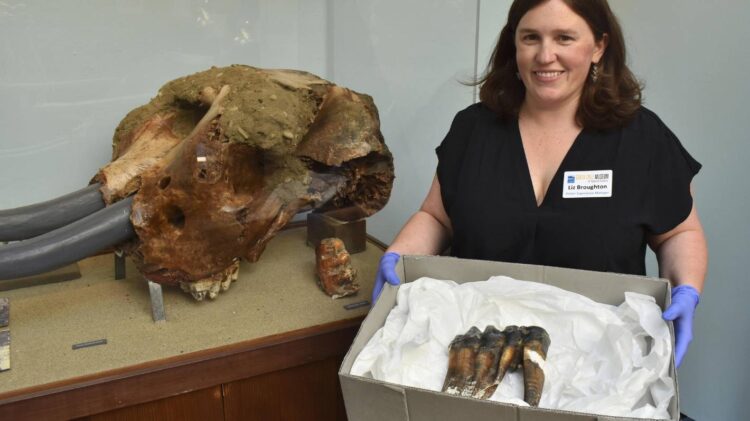Woman Finds Ancient Mastodon Tooth on California Beach: Unearthing Clues to Earth’s Prehistoric Past
In a remarkable twist of fate, a woman strolling along a picturesque California beach stumbled upon a rare and extraordinary discovery—an ancient mastodon tooth. The chance find not only astonished the woman but also captured the attention of archaeologists and paleontologists worldwide. The tooth’s emergence from the depths of time presents a unique opportunity to delve into the prehistoric past, unlocking secrets about the long-extinct creatures that once roamed the Earth.
The Discovery:
The discovery took place on a sunny morning when Emma Collins, an avid beachcomber, decided to explore the shores of a secluded beach in California. As she meandered along the shoreline, her eyes caught sight of a peculiar object nestled among the shells and pebbles. To her astonishment, it was a large, well-preserved tooth, distinctively different from anything she had ever encountered before.
Realizing the potential significance of her find, Emma promptly contacted local authorities, who in turn alerted paleontologists at the nearby Natural History Museum. The tooth, identified as belonging to a mastodon—a distant relative of the elephant—was carefully examined and authenticated by experts, confirming its ancient origins.
The Significance:
The discovery of the mastodon tooth on a California beach carries immense significance for scientists and enthusiasts of natural history. Mastodons, massive herbivorous mammals, inhabited the Earth millions of years ago during the Pleistocene epoch. Unraveling the secrets concealed within this tooth could provide valuable insights into the creature’s life, behavior, and habitat.
Paleontologists are particularly interested in studying the enamel and dentin of the tooth. These organic materials preserve vital information about an animal’s diet, growth patterns, and evolutionary adaptations. Through meticulous analysis of the tooth’s composition, scientists can deduce the mastodon’s feeding habits, helping to reconstruct the ancient ecosystem in which it thrived.
Furthermore, the geological context of the discovery site can offer clues about the region’s environmental history. By conducting geological surveys and examining sedimentary layers, researchers can gain a deeper understanding of the ancient landscape and the ecological conditions that shaped it. This information helps scientists piece together the puzzle of how mastodons and other prehistoric creatures interacted with their surroundings.
Beyond the scientific realm, the mastodon tooth also provides a window into the rich cultural heritage of indigenous peoples who have long inhabited the region. Native American communities have revered mastodons and mammoths, crafting myths, legends, and art that depict these majestic creatures. The discovery serves as a reminder of the deep-rooted connections between humans and the natural world throughout history.
Preservation and Future Research (approx. 400 words):
Preserving and studying the mastodon tooth is of paramount importance for future research. Museum curators and scientists will employ meticulous techniques to protect and conserve the tooth, ensuring that it remains intact for further analysis and public exhibition.
Researchers are planning a range of investigations to unlock the tooth’s secrets. Utilizing advanced imaging technologies, they will create detailed 3D models of the tooth’s structure, allowing for non-invasive examinations and measurements. This data will contribute to comprehensive databases, aiding comparative studies with other mastodon fossils found across different regions.
Isotopic analysis, a technique used to analyze the elemental composition of teeth, will provide further insights into the mastodon’s diet and migration patterns. By studying isotopic signatures preserved in the tooth’s enamel, scientists can reconstruct the animal’s movements and potentially uncover evidence of ancient migration routes.
Collaboration among scientists, archaeologists, and local communities will be crucial in fully understanding the significance of this discovery. The collaboration will involve sharing knowledge, resources, and expertise to ensure that the mastodon tooth’s discovery is maximized for scientific and educational purposes.
Public engagement and education will also play a vital role in this process. Museums and research institutions can organize exhibits, lectures, and workshops to raise awareness about the significance of the mastodon tooth and its implications for our understanding of Earth’s prehistoric past. This outreach effort can inspire young minds and foster a sense of wonder and curiosity about the natural world.
In addition to the mastodon tooth itself, the beach where it was found holds potential for further discoveries. Continued exploration of the area, in collaboration with local communities and authorities, may unearth additional fossil specimens or artifacts that shed light on the region’s ancient history.
The discovery of the mastodon tooth on a California beach serves as a powerful reminder of the vast expanse of time that precedes us and the mysteries that lie within our planet’s geological layers. It highlights the importance of preserving and studying Earth’s natural history, not only to unravel the secrets of prehistoric life but also to foster a deeper appreciation for the interconnectedness of all living beings and the significance of preserving our planet’s biodiversity.
The chance discovery of an ancient mastodon tooth on a California beach has sparked excitement and intrigue among scientists, researchers, and the public alike. This remarkable find provides a rare glimpse into Earth’s prehistoric past and offers valuable insights into the life and habitat of these magnificent creatures.
As scientists delve into the tooth’s composition, conduct further research, and engage in collaborative efforts, we can expect to unravel more secrets about the mastodon’s diet, behavior, and environment. The tooth’s preservation and careful study will contribute to our understanding of the Pleistocene epoch and shed light on the interconnectedness of ecosystems throughout history.
This discovery also serves as a catalyst for public engagement, inspiring curiosity and appreciation for the natural world. By sharing the story of the mastodon tooth through exhibitions, educational programs, and outreach initiatives, we can foster a deeper understanding of Earth’s rich biodiversity and the importance of preserving our planet for future generations.
The mastodon tooth on the California beach is a symbol of our shared history and the endless wonders that await discovery. It reminds us that beneath our feet lie hidden treasures that can unravel the mysteries of the past and guide us toward a more sustainable future.



No Comments
Leave Comment